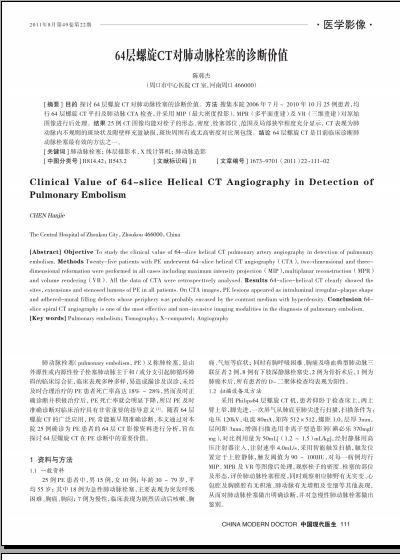64层螺旋CT对肺动脉栓塞的诊断价值(1)
 |
| 第1页 |
参见附件(1936KB,2页)。
[摘要] 目的 探讨64层螺旋CT对肺动脉栓塞的诊断价值。方法 搜集本院2006年7月~2010年10月25例患者,均行64层螺旋CT平扫及肺动脉CTA检查,并采用MIP(最大密度投影)、MPR(多平面重建)及VR(三维重建)对原始图像进行后处理。结果 25例CT图像均能对栓子的形态、密度、栓塞部位、范围及局部狭窄程度充分显示,CT表现为肺动脉内不规则的斑块状及附壁样充盈缺损,斑块周围有或无高密度对比剂包绕。结论 64层螺旋CT是目前临床诊断肺动脉栓塞最有效的方法之一。
[关键词] 肺动脉栓塞;体层摄影术,X线计算机;肺动脉造影
[中图分类号] R814.42;R543.2 [文献标识码] B [文章编号] 1673-9701(2011)22-111-02
Clinical Value of 64-slice Helical CT Angiography in Detection of Pulmonary Embolism
CHEN Hanjie
The Central Hospital of Zhoukou City,Zhoukou 466000,China
[Abstract] Objective To study the clinical value of 64-slice helical CT pulmonary artery angiography in detection of pulmonary embolism. Methods Twenty-five patients with PE underwent 64-slice helical CT angiography(CTA),two-dimensional and three-dimensional reformation were performed in all cases including maximum intensity projection(MIP),multiplanar reconstruction(MPR) and volume rendering(VR). All the data of CTA were retrospecttvely analysed. Results 64-slice-helical CT clearly showed the sites,extensions and stenosed lumens of PE in all patients. On CTA images,PE lesions appeared as intraluminal irregular-plaque shape and adhered-mural filling defects whose periphery was probably encased by the contrast medium with hyperdensity. Conclusion 64-slice spiral CT angiography is one of the most effective and non-invasive imaging modalities in the diagnosis of pulmonary embolism.
[Key words] Pulmonary embolism;Tomography;X-computed;Angiography
肺动脉栓塞(pulmonary embolism,PE)又称肺栓塞,是由外源性或内源性栓子栓塞肺动脉主干和/或分支引起肺循环障碍的临床综合征,临床表现多种多样,易造成漏诊及误诊,未经及时合理治疗的PE患者死亡率高达18%~28%,然而及时正确诊断并积极治疗后,PE死亡率就会明显下降,所以PE及时准确诊断对临床治疗具有非常重要的指导意义[1]。随着64层螺旋CT的广泛应用,PE常能被早期准确诊断,本文通过对本院25例确诊为PE患者的64层CT影像资料进行分析,旨在探讨64层螺旋CT在PE诊断中的重要价值。
1 资料与方法
1.1 一般资料
25例PE患者中,男15例,女10例;年龄30~79岁,平均55岁;其中18例为急性肺动脉栓塞,主要表现为突发呼吸困难、胸痛、胸闷;7例为慢性,临床表现为剧烈活动后咳嗽、胸痛、气短等症状;同时有胸呼吸困难、胸痛及咯血典型肺动脉三联征者2例,8例有下肢深静脉栓塞史,2例为骨折术后,1例为肺癌术后,所有患者的D-二聚体检查均表现为阳性。
1.2 扫描设备及方法
采用Philips64层螺旋CT机,患者仰卧于检查床上,两上臂上举,脚先进,一次屏气从肺底至肺尖进行扫描,扫描条件为:电压120kV,电流80mA,矩阵512×512,螺距1.0,层厚3mm,层间距3mm,增强扫描选用非离子型造影剂(碘必乐370mgI/mg),对比剂用量为50mL[(1.2~1.5)mL/kg],经肘静脉用高压注射器注入,注射速率4.0mL/s,采用智能触发扫描,触发位置定于上腔静脉,触发阈值为90~100HU,对每一病例均行MIP、MPR及VR等图像后处理,观察栓子的密度、栓塞的部位及形态,评价肺动脉栓塞程度,同时观察相应肺野有无实变、心包腔及胸膜腔有无积液、肺动脉有无增粗及变细等其他表现,从而对肺动脉栓塞做出明确诊断,并对急慢性肺动脉栓塞做出鉴别。
2 结果
2.1 肺动脉栓塞的范围
25例肺动脉栓塞者18例为急性肺动脉栓塞,7例为慢性肺动脉栓塞,左右肺动脉主干栓塞9支,其中一支为骑跨于左右肺动脉主干的骑跨性栓塞 ......
您现在查看是摘要介绍页,详见PDF附件(1936KB,2页)。